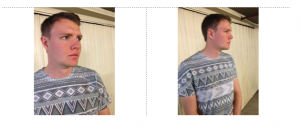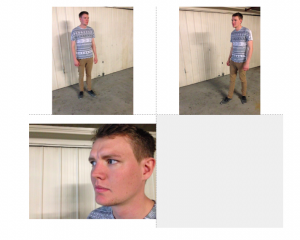‘Playtime’ directed by Jacques Tati.
The scene begins with an establishing wide shot of the main male character positioned to the right of frame, in a room with monochrome colours, and symmetrical room decor. Going off the Rule of Thirds, character 1 is positioned within an intersection of the grid. The character then sits on a chair in the bottom right hand corner of the frame. Having everything within the set the same, allows the character to stand out through movement, as he is the only one there. However, placing him to the right of frame creates cues for the audience, suggesting that something else is going to happen in the rest of the frame, because Tati wouldn’t leave the shot uneven. This is a still shot, allowing the character movements to guide the audience’s attention around the frame. Two people then enter from a door, filling the space within the frame, and fulfilling the audience’s expectations. However, one walks back through the door, leaving just two characters in the room. Character 2 then sits on another chair that is situated within the other intersection of the Rule of Thirds, balancing the frame. As the new characters were being introduced the camera tracks into the remaining two characters, suggesting to the audience that they are the main focus, and that is where they should be focusing. As one character moves, the other does respectively, creating a symmetrical shot. When the director wants to focus on one character the camera will have them in the foreground with the other in the background. As one of the characters moves, the other is completely still, this is done so that no attention is taken away from the character positioned in the foreground. This shot still goes on the Rule of Thirds, with each character placed within the main focus points. Having the camera angles change, suggests that we are seeing the action from different characters’ perspective. For the duration of the scene, character 1 has stayed in the same position within the frame, however at the end of this scene, the man comes back through the door summoning character 2, and they then leave the room; leaving character 1 alone, just like the beginning of the scene. From here, character 1 gets up off the chair and walks across the room, which destroys the audience’s expectations, however by the positioning within the frame we knew something had to happen within the blank space.


